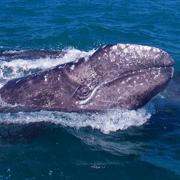 Going hungry? If the whale populations are smaller now than in the past, then why are they running out of food?Geoff Shester
Going hungry? If the whale populations are smaller now than in the past, then why are they running out of food?Geoff ShesterThe Pacific Ocean may have once teemed with three to five times as many grey whales as live there today, according to a genetic study led by researchers at Stanford University's Hopkins Marine Station in Pacific Grove, California.
Unfortunately, the modern population doesn't seem to be doing well, showing signs of malnutrition. Previously it was thought that this could be due to the stress of overpopulation. But if today's whale community is actually quite small compared with historical levels, the team suggests, some other effect must be limiting the amount of food available to the whales — perhaps changes in climate.
Grey whales have long been thought to have bounced back completely from whaling, which nearly wiped out the species in the 1850s and early 1900s. Marine biologists have estimated that the Pacific grey whale population is now about 22,000 individuals, and some biologists have speculated that this is the species' 'carrying capacity', or its natural maximum population.
But when Stanford University graduate student Elizabeth Alter and her colleagues surveyed the genetic diversity of 42 whales, they found it was higher than they would have expected if past populations were as small as they are today. Instead, their data suggest that past grey whale populations may have numbered as high as 96,000 animals in the Pacific, they report in the Proceedings of the National Academy of Sciences1.
"We've tended to rely on human records, such as logbooks of whaling voyages, to estimate historical whale population sizes," says Scott Baker, a marine biologist at the Marine Mammal Institute at Oregon State University in Newport, who did not participate in the research and welcomes the approach. "Looking at the genomes of the surviving population is an independent way of trying to verify or challenge that history, and the estimates in this paper are much larger than those that have been accepted by whaling biologists for the last 20 to 30 years."
Times past
This conclusion has many implications, says Alter. It suggests that grey whale populations have not fully recovered from whaling, so managers should aim to reduce the number of grey whales killed in accidents and other mishaps.
It also gives a picture of what the oceans may have looked like before large-scale commercial exploitation. "One of the exciting things about the study is the idea that we can use genetics to reconstruct what the oceans used to look like," Alter says. "There is so little information we can turn to, to help us understand that; to have this source of data is very exciting."
Alter points out that grey whales have an important effect on ocean ecosystems, because they feed by plowing through the mud at the bottom of the seafloor, straining out small marine crustaceans as they go. This 'bulldozing' strategy churns up sediments and small creatures that serve as food for other animals, such as sea birds. Writing in today's study, Alter estimates that a pre-whaling population of 96,000 grey whales could have stirred up food for more than 1 million sea birds, for example.
Signs of stress
The study also provides a crucial piece of a puzzle that has been worrying marine biologists over the past few years. Through the 1980s and 1990s, grey whale populations grew steadily, and female whales gave birth to new calves approximately every 2 years. But in 1998 and 1999, the grey whale population dropped by one-third.
ADVERTISEMENT
Since then, scientists have begun spotting hundreds of 'skinny' whales — animals that seem to be suffering from malnutrition — along the coast. They have also noticed that the grey whales have begun feeding farther north than they used to, and have begun shifting their feeding strategy away from sifting through seafloor mud towards eating prey suspended in the water column.
If this isn't due to whales reaching the limit of their natural carrying capacity, it could instead be the effects of climate change on the whales' prey. If their food is moving or becoming less plentiful, then that could erode the gains made by the species over the past half-century, says Steven Swartz of the National Marine Fisheries Service in Silver Spring, Maryland.
"We're seeing that, on average, females are calving less frequently, and that's a concern," Swartz says. "One reason grey whales did so well in the 1980s and 1990s was because they were breeding so well, and if they're not breeding, that could have a real impact."
Visit our analysisrevealssizeof_p.html">newsblog to read and post comments about this story.
